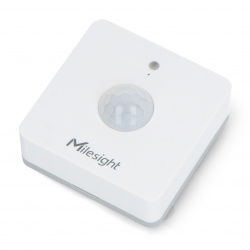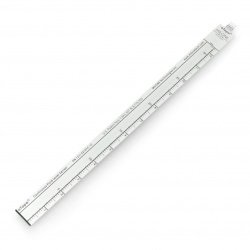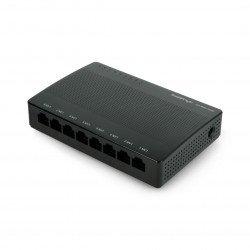In case of some types of communication interfaces, e.g. RS485, it is possible to connect many devices in a kind of parallel way, i.e. by direct connection of the corresponding data and power wires. However in case of such complex interfaces as Ethernet the use of galvanic splitters turns out to be impossible. To extend a wired (computer) network with additional elements, it is necessary to use special devices. From the user's point of view, network switches, also called network switches, work somewhat similarly to the popular USB hubs: they allow you to connect to a single port of e.g. a router or a computer, many devices equipped with this particular interface. In this category, we present network switches adapted to different applications and provide a range of additional functionality.
Switche, przełączniki sieciowe
Deskop Switch Lanberg DSP2-1005-12V 5 ports 1000Mbps
10/100/1000 Mbps network switch with 5 Gigabit Ethernet compatible RJ-45 ports . It is a plug-and-play device, requiring no additional configuration. The switch has...Deskop Switch Lanberg DSP2-1008-12V 8 ports 1000Mbps
Lanberg 10/100/1000 Mbps switch . It has 8 RJ-45 ports, compatible with Gigabit Ethernet standard. The network switch has an option of automatic connection negotiation, it...Switch for 10''/19'' server racks - 16 1000Mbps ports - Lanberg RSGE-16
The Lanberg RSGE-16 switch is an unmanaged network switch dedicated to installation in 10" and 19" rack cabinets . Equipped with 16 Gigabit Ethernet ports , it offers...See also
Unmanaged vs. managed switches
The basic difference between different models of network switches is the ability (or lack thereof) to manage parameters - usually through a browser interface. Unmanaged switch is the simplest possible version of network switch, which works on plug and play principle, so it allows to expand the network practically without any additional operations. It is enough to connect suitable end devices, e.g. computers, network printers, measuring equipment or minicomputers (e.g. Raspberry Pi) to a single RJ-45 port present e.g. in modem or network router. Most routers available on the market (e.g. fiber optic or ADSL routers) allow to connect a few (usually up to 4) devices with Ethernet interface, but having at hand more computers or other devices with access to the network it is very easy to exceed this number. That's why it is worth - in the case of extending the network for several household members or in a small company - to think about installing an appropriate switch. Managed switches allow to run simple configuration interface and set parameters of individual subnetworks. This process allows to increase reliability of the whole LAN or limit access of unauthorized users to some devices.
Switch size and other performance parameters
The second very important parameter of the network switch, which strongly affects the possibility of its use in specific applications, is the number of ports. Usually Ethernet switches are made in 4-, 5-, 8-, 16-port versions, but other configurations are also available. In the case of switches with more than 8 ports, the casing is usually equipped with two-row RJ-45 sockets - this allows to significantly reduce the overall dimensions of the device by denser packing of connectors. Switches in basic versions, for home or small business applications, are made in plastic housings, while professional models - usually those with a large number of ports (above 8) - are usually closed in robust metal housings designed for mounting in rack type systems. The housing then has the appropriate brackets and mounting holes. Some switches are powered by external power supply with DC plug, while other, larger models for professional use, have built-in power supply and for their power supply an IEC-type network cable is used.
Offer of network switches in Botland store
In our offer we have gathered a number of models adapted to the needs of all users. You will find there switches that allow to develop both small home networks and large ICT infrastructures. The smallest solutions include switches such as Tenda S105 offering 5 Ethernet ports and enclosed in a housing with dimensions of only 82 x 52 x 22 mm. This model supports full duplex and half duplex mode. Larger models, e.g. TP-link TL-TL-SF1008D, have 8 ports and their casing - similarly to the device described above - is made of plastic. If you need a robust, industrial solution for ICT applications, pay attention to the offer of Hored company, such as 24-port model NS6024L. One of the smallest switches on the market is the Tinycontrol POESWG-030 with 4 Ethernet 10/100Mbit ports and one Gigabit Ethernet port. PoE technology allows you to power devices such as IP surveillance cameras and even some minicomputers without using an additional power cable or charger.

















































































































































































































































































































































